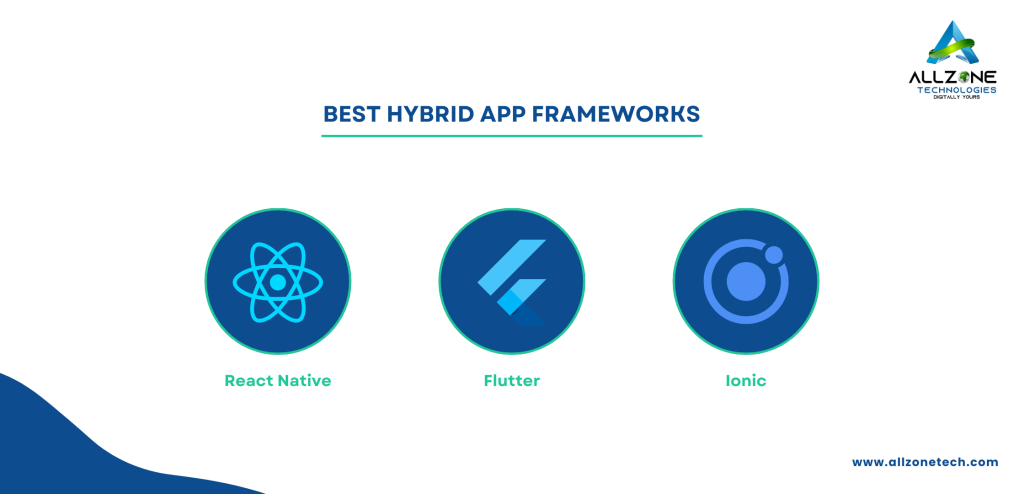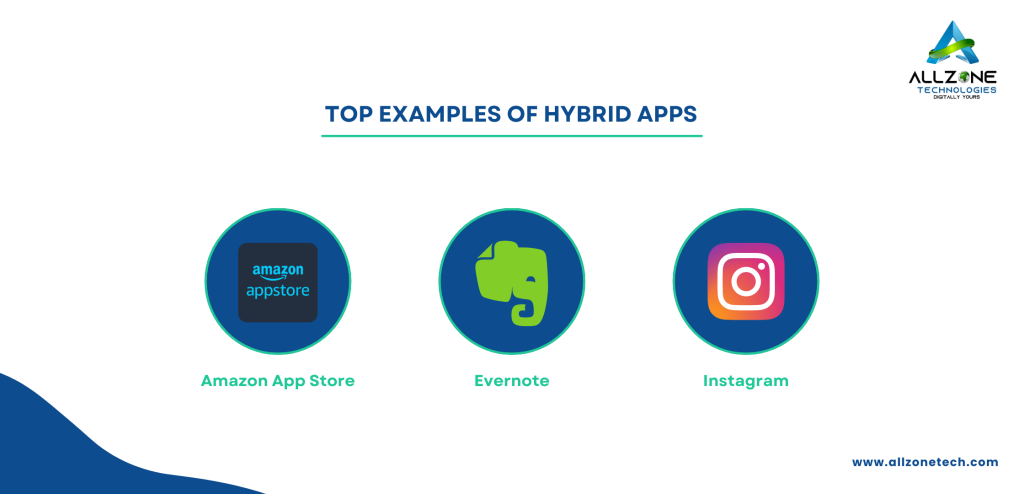
-
AllZoneAdmin
- August 8, 2024
Hybrid App Development: A complete Understanding of Core Concepts
As we know, Mobile phones are the top-tier need of this century. Moreover, everyone is using a mobile phone these days. So, the companies must build high-end apps that run on various platforms. We should thank new technologies for building apps across multiple platforms. These are known as Hybrid App Development. Now, we’ll explore the core concept of Hybrid app Development.
You can spot people using mobile phones everywhere. Moreover, the ratio of mobile phone apps and app users is rising rapidly. This will alert companies to build mobile phone apps. Imagine creating apps that run on Android, IOS, Tablets, and Laptops. Sounds nice? So, it is a smart and cost-effective way to make things easier for companies.
Hybrid app development is a trending topic now. Because they help to build efficient and budget-friendly apps on multiple platforms. In addition, it has combined features of native and web app development. However, some businesses still face difficulty choosing between hybrid and native apps.
In this blog, we`ll clarify the pros and cons of native and hybrid app development. However, businesses still opt for hybrid due to their pros. According to a Forbes report, 37 out of 50 apps are built on hybrids in the US. Additionally, popular apps like Instagram, Twitter, and Gmail use hybrid apps.
Now, Let’s explore what are hybrid app development and its core concepts
What is Hybrid App Development?
Hybrid app development means building apps that combine features of web and native apps. Moreover, these apps are written in HTML5, CSS (Cascading sheet), and JavaScript. In addition, they work across multiple platforms, such as Android and iOS. They`re great for fulfilling cross-platform needs. They are moreover, providing cost-effective solutions for business growth.
Hybrid app frameworks ensure a seamless user experience. With its higher efficiency, function, and interface. Moreover, Apps like Instagram, Gmail, and Twitter are top examples of this. This helps businesses to ensure the best user experience.
However, Hybrid app development has some limitations too. Although it is a good choice for businesses but not for all. Hence, to check whether this is the best option for your company. You need to do some proper research on the pros and cons of Hybrid development.
Therefore, before studying deep concepts of hybrid application development. First briefly discuss differences among native and hybrid apps.
Hybrid and Native App Development: Key difference and Comparison
Now, compare Hybrid and native app development. Moreover, this helps to clarify which framework you should choose.
Native app
Native apps are created from scratch, mainly designed for specific operating systems. Additionally, their main goal is to fulfill functionality. As native apps develop for specific OS. Therefore, they provide high security and performance. However, these are not suitable for cross-platforms app development to create superior applications. In addition, these apps work well on the Apple App Store and Google Store. Native apps programmed in different languages. Such as Swift for custom iOS app development, java, and Kotlin for custom Android app development.
Hybrid App
Hybrid apps built using web technologies. These are HTML, CSS, JavaScript, and Python. Moreover, they are designed to operate across multiple platforms. Providing cross-platform compatibility. Hybrid apps ensure high security like native apps due to their efficient framework. Developers pick hybrid app development for its efficiency and superior feature quality.
How Do Hybrid Applications Design and Develop?
Typically, hybrid application code is built using web technologies. Such as HTML, CSS, and JavaScript. Furthermore, code is encapsulated in a native shell or container, called WebView. This ensures apps run on multiple OS. Moreover, native shells enable hybrid apps to utilize native features and APIs. Additionally, allowing to integration of hardware elements like cameras and GPS.
When the app operates, web content is visible inside the native shell. Moreover, it enables connection between HTML code and native apps. Modern frameworks like React native use JavaScript code in machine code. This improves efficiency and makes the app feel more like a native app.
Hybrid App: Enlisting Top Features
- Apps running offline without any connection
- Seamless integration with multiple devices
- Integration with web based apps
- Built in browser to access web content
- Portable functionality: one source code used on various devices
- Easy to handle software and hardware using plug-ins
- Budget-friendly approaches
- Develop apps efficiently on different platforms
Now, Let’s discuss important part: pros and cons of Hybrid Application Development
Advantages of Hybrid Application Development
Hybrid apps take less time, low-cost than native apps. Here are advantages of hybrid apps:

Smooth Scalability
Hybrid apps rely on a single codebase. So, it is easy to develop apps across various devices. Moreover, apps developed for IOS can easily launch on Android. It is compatible for both android and IOS development.
Faster App development time
As only one codebase is used to manage. So, it takes less time to develop hybrid apps. This is one reason why hybrid apps are better than native apps.
Less development expense
Hybrid mobile application development is less costly as compared to native apps. Because, Developers write code only once. This reduces initial and maintenance cost.
Centralized codebase function
As compared to native app development, which develops two separate apps. Hybrid app development allows one to build an app once using a single codebase. This simplifies the process of managing a single database.
Disadvantages of Hybrid Application Development
Performance lack
Hybrid apps perform not as well as compared to native apps. Because these apps are not great to do complex tasks.
Less integration with native features
Hybrid apps can access native features but with limitations. They may not fully support app functions as compared to native apps.
Low user interface
The user experience may not be responsive or up the mark. In contrast of native app, which enhance overall user satisfaction.
Error- Sensitivity
Hybrid apps have some hidden errors and glitches.
Accessibility of features
Hybrid apps have updated features which may not present in other operating systems. Moreover, some native app development features might not be present in hybrid apps.
Hybrid App Development: Top Frameworks 2024
A hybrid app development top 10 framework helps developers to use web technologies to create hybrid apps. Some of the top hybrid app development frameworks are the following:

Flutter: Expanding Mobile app boundaries
Google developed and available in 2017. Flutter is a flexible approach for developers to create apps for both IOS and Android. Flutter uses dart programming language to work seamlessly across other platforms. Moreover, it`s popularity rises because of Google’s involvement and flexibility. People enjoy flutter due to the friendly learning process and quick get ideas into the app. Moreover, it earns high ratings from those who use it. Example of flutter app development is:
- Google ads
- Hamilton
- Google play
React Native: Developed by Facebook team
Facebook launch react native in 2018. It is based on JavaScript framework. Moreover, it gains popularity because of their “write once, run everywhere” approach. Developers like to use this framework to create high quality apps for both IOS and android using single codebase. Now, it`is broadly used, almost 42% mobile developer use it regularly.
Top React native apps are:
- Skype
Iconic: Great open-source approach
Iconic is an open-source framework. It is using web technologies (HTML, CSS, JavaScript) to develop mobile, web and desktop apps. Moreover, it allows developers to create apps using a single codebase across other platforms. Additionally, Deployment process is quite high and efficient.
Notable apps using iconic
- JustWatch
- Pacifica
- Nationwide
Top Leading Hybrid Apps
Here, some top hybrid apps help businesses to make a great impact in industries. Moreover, Businesses opt for hybrid app development for their ease. They are:

Amazon leading hybrid app
Amazon is a top tier example of hybrid apps. It uses HTML5 to operate seamlessly and improve user experience. Moreover, the app has a mind-blowing user interface that attracts larger users.
Image here
Instagram is the top leading social-network. Interestingly, while Instagram is a multi-platform app, Facebook was initially created as native app.
You might know Cristiano Ronaldo is the most followed Instagram personality. Did you know the US is the second country that has the highest number of users on Instagram? . According to a Statista report, it hits 169.65 million users globally. Amazing? So, it is quite visible Instagram is the most popular example of these apps. Moreover, as a top social media app it runs on HTML5 and easily manages data online and offline.
Evernote
Evernote is the top most productive app. It is not a native app. It is a hybrid app with excellent performance and sync capabilities. Furthermore, the multiplatform sync capabilities of these hybrid apps make it more productive and efficient. Evernote provides native app features which attract user’s attention.
Best Strategies for Scalable Hybrid App Development
When creating hybrid app development, follow some strategies to create scalable, money-saving, and high feature apps. Here are some strategies for seamless hybrid app development:
Apply High-security practices
Ensure proper authentication and encryption processes to secure your apps.
Pick top hybrid Frameworks
Adopting a top framework ensures higher security and scalability in hybrid apps.
Prioritize basic Design
A basic and simple app design of hybrid apps will reduce time and effort.
Opt built-in Web technologies
Using built-in web technologies saves development time and costs.
Boost efficiency
Optimize your code for higher efficiency and speed, which is key for hybrid apps.
Prioritize proper testing
Before releasing, ensure proper testing to make sure the app is scalable and error-free.
Conclusion:
As a result, hybrid application development is a key solution in various mobile app landscapes. This approach allows businesses to reach their audience quickly across multiple platforms. Apps like Instagram and Gmail deliver great accessibility and user experience by integrating web and native app technologies. Additionally one must carefully select between hybrid and native development due to performance issues and integration difficulties. So, choosing the right framework and smart strategies is the key to maximizing the benefits of these apps. This simply results in growth and successful digital solutions.

